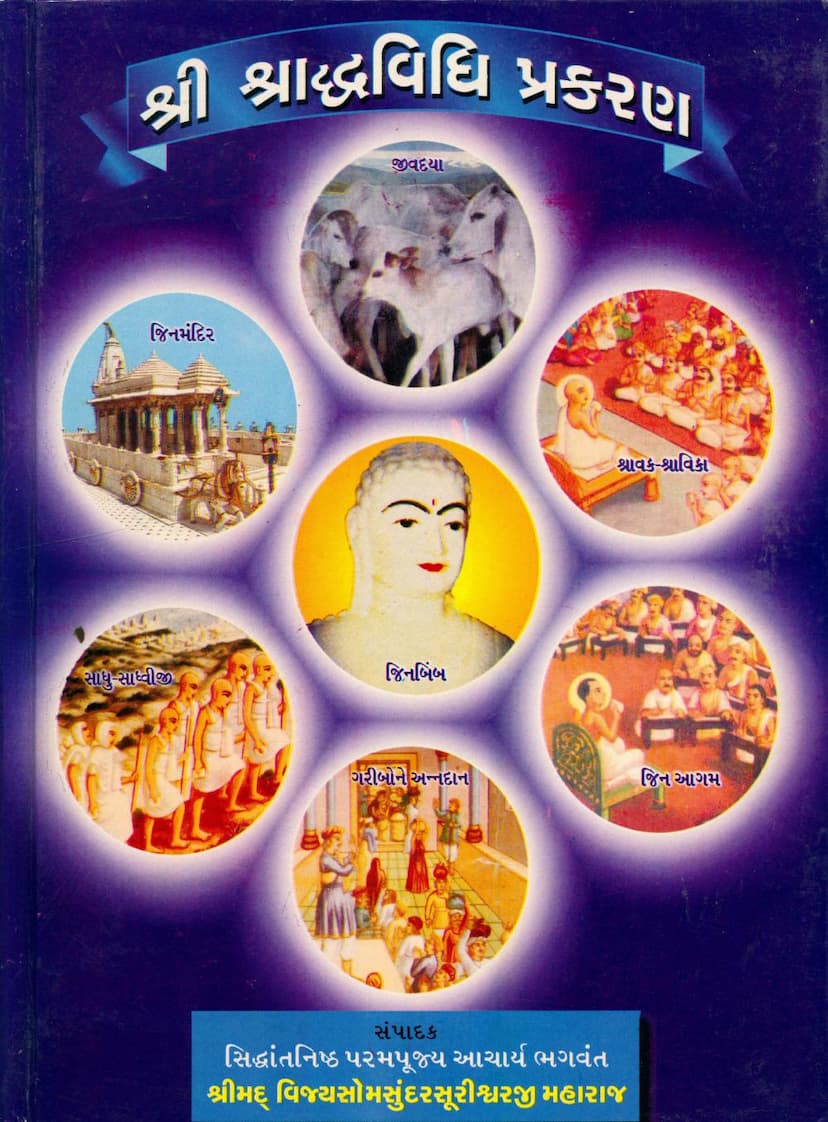Shraddh Vidhi Prakaran
Added to library: September 2, 2025

Summary
Here is a comprehensive summary of the Jain text "Shraddh Vidhi Prakaran" by Somsundarsuri, based on the provided pages and catalog link:
Book Title: Shraddh Vidhi Prakaran (Practices for the Devout Layperson) Author: Somsundarsuri (as per the editor's credit) and originally attributed to Ratnashekhar Suri (as per the editor's note referencing his work). Publisher: Shri Shantichandra Suri Jain Gyanmandir, Ahmedabad. Catalog Link: https://jainqq.org/explore/022172/1
Overall Purpose:
The "Shraddh Vidhi Prakaran" is a significant Jain text, originally composed in Prakrit (Magdhi language) and expanded with an extensive Sanskrit commentary called "Shraddh Vidhi Kaumudi" by the author. The Gujarati translation and compilation, edited by Acharya Shrimad Vijay Somsundarsurishwarji Maharaj, aims to provide a comprehensive guide for lay Jains (Shravaks and Shravikas) on their daily conduct, religious observances, and ethical responsibilities. The book emphasizes the importance of adherence to scriptural injunctions, guidance from learned spiritual masters, and meticulous performance of religious practices according to prescribed rituals (vidhi) for achieving spiritual progress and ultimately, liberation (moksha).
Key Themes and Content:
The text is structured to guide the lay follower through various aspects of Jain life, both daily and during significant periods. The preface highlights the cyclical nature of existence (samsara) and the importance of the Vitrag Dharma (path of the liberated beings) for overcoming karmic bonds. It stresses that true religious observance requires adherence to scriptures, the guidance of spiritual leaders, and the correct performance of rituals. The text lamrnts the prevalence of superficial or ritualistic religion in the current era and urges readers to embrace faith (shraddha) and proper conduct (vidhi).
The book covers the following main aspects of a Shravak's life, divided into six main sections (Prakash):
-
Dinkrutya (Daily Duties): This section details the prescribed daily rituals and practices for a lay Jain. It begins with the importance of waking up early, reciting the Navkar mantra, and understanding its significance. It includes practices like purification, daily prayers (Chaityavandan), observing dietary restrictions (Abhakshya), the proper methods for cleaning and performing rituals, and the importance of mindfulness in all actions. It also delves into the meanings of various elements in Jain worship, such as the significance of different types of offerings and the proper way to conduct them. The text emphasizes the importance of knowledge and understanding behind these rituals.
-
Ratrikrutya (Nightly Duties): This section likely covers the evening observances, prayers, and reflections before sleep, reinforcing the principles of self-discipline and spiritual remembrance throughout the day. It includes details on performing Pratikraman (confession and repentance) and Samayik (meditative practice).
-
Parva Krutya (Festival Duties): This section focuses on the specific observances and practices to be followed during auspicious days and festivals in the Jain calendar. It highlights the significance of these days for enhanced spiritual practice, fasting (Pauṣadha), and devotion. It discusses the importance of observing the correct time for rituals based on lunar phases (tithi) and celestial influences (nadaadi).
-
Chaturmasik Krutya (Duties during Chaturmas): This section details the specific practices and vows that lay Jains should undertake during the four-month monsoon period (Chaturmas), a time of intensified spiritual discipline. It includes guidelines on increased austerities, refraining from certain activities, and focusing on spiritual study and reflection.
-
Varshik Krutya (Annual Duties): This section covers the annual observances, likely including the main Jain festivals like Paryushana, Mahavir Jayanti, Diwali, and others, outlining the specific rituals and practices associated with them. It emphasizes the importance of yearly introspection and renewed commitment to the faith.
-
Janma Krutya (Birth-related Duties): This section addresses rituals and observances related to significant life events, such as the birth of a child. It likely includes practices related to prenatal care, naming ceremonies, and the upbringing of children within the Jain framework, emphasizing the importance of instilling spiritual values from a young age. This section also includes extensive narratives and examples, such as the story of Shukraja, which illustrates moral principles and the consequences of actions.
Key Highlights and Principles:
- Importance of Vidhi (Ritual): The text repeatedly stresses that performing religious duties correctly and with proper ritual is crucial for their efficacy and for spiritual progress.
- Shraddha (Faith) and Bhakti (Devotion): The book underscores the necessity of genuine faith and devotion in all religious practices.
- Discipline and Conduct: It provides detailed guidance on daily conduct, dietary rules, the avoidance of forbidden actions (Abhakshya), and the importance of ethical behavior in all aspects of life.
- Spiritual Guidance: The text emphasizes the need to follow the teachings of Tirthankaras, Acharyas, and Upadhyayas, and to seek their guidance.
- Moral and Ethical Living: The narratives and examples within the text, like the story of Shukraja and others, serve to illustrate the moral and ethical principles of Jainism, including the consequences of one's actions.
- The Shravak's Role: The book is specifically tailored for lay followers, outlining their duties and respons1ibilities in upholding the Jain path while living a householder's life.
- Inclusion of Stories and Examples: The text is enriched with illustrative stories and examples from Jain tradition, making the spiritual teachings more accessible and memorable. These stories often highlight the karmic consequences of actions and the importance of righteous living.
Structure and Content Detail:
The index (Vishay Suchi) provided in the initial pages gives a detailed outline of the topics covered, which span from daily routines (Dinkrutya) to specific rites for festivals, Chaturmas, annual observances, and even life events like birth. It touches upon detailed practices such as the significance of the Navkar mantra, the rules of purification, the conduct during worship, the importance of charity, ethical business practices, and the nuances of adhering to vows and regulations. The extensive index itself demonstrates the book's comprehensive nature.
In essence, "Shraddh Vidhi Prakaran" serves as a practical manual for Jain laypeople, guiding them on how to lead a life aligned with their faith, perform their religious duties with diligence, and cultivate spiritual merit through consistent practice and ethical conduct.